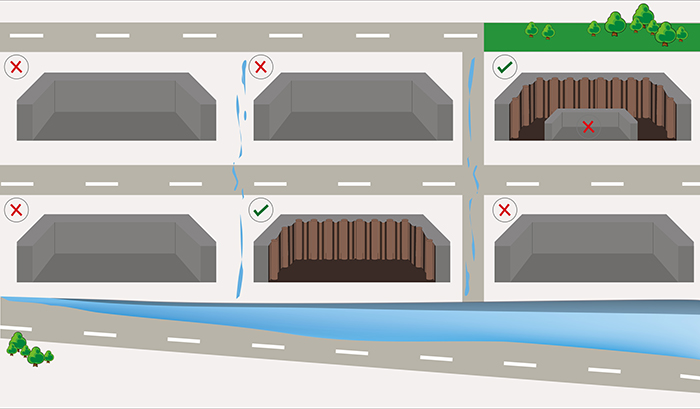Sheet piles are the obvious foundation of Sponge Cities
Trillions of liters of fresh water drop from the sky onto the world’s cities each year – yet most of it is channeled straight into gutters, drains and rivers. At best, this represents a waste of a valuable natural resource. At worst, it can lead to devastating urban floods that kill residents and destroy thousands of homes. With cities getting bigger and climate change threatening to bring more extreme weather, the Chinese government is proposing “sponge cities”, a reconsidering of the urban environment where almost every raindrop is captured, controlled and reused.
Instead of funneling rainwater away, a sponge city retains it for use within its own boundaries. Rainwater can be used to recharge depleted aquifers or irrigate gardens and urban farms. China has now chosen 16 urban districts across the country, including Ningbo, Wuhan, Chongqing and Xiamen, to become pilot sponge cities. Over the next three years, each will receive up to 600m yuan to develop ponds, filtration pools and wetlands, as well as to build permeable roads and public spaces that enable storm water to soak into the ground. Ultimately, the plan is to manage 60% of rainwater falling in the cities.
One of the best solutions for increasing cities water retention capacity, is already available! Changing foundation practices for retaining walls from diaphragm walls to temporary steel retaining walls is an easy first step that will immediately and permanently increase the water retention capability of cities and replenish aquifers and guard against the subsidence of the soil leading the city to sink.
All temporary walls that have no function in the structure being built - such as load bearing capacity or subterranean walls for parking garage - should immediately be designed with sheet piles instead to meet sponge city goals.

The problems are made worse in China because of the local practice of building diaphragm walls for every real estate development in the country, one adjacent to the next in an endless pattern concreting over the urban landscape. Diaphragm walls are permanent concrete structures that are used for temporary excavation of underground space. In the dense Chinese urban landscape this practice has concreted up practically all the surfaces of the city scape, locking out rain water from the soil and pushing every rain drop directly into the sewer system. Although diaphragm walls are often the only practical solution for very deep excavations, shallow and medium depth excavations of up to 18 meters can be executed with temporary sheet pile or sheet pile combination walls, also known as sponge foundations.

Definition: Sponge Foundation
A sponge foundation is a temporary steel retaining wall made out of reusable sheet piles or steel casings, driven and extracted by resonance free vibratory hammer. It must have the dual function of allowing rainwater to permeate deep into soil, and of low environmental impact (airborne pollution, waterborne pollution, CO2 emissions, resonance damage, traffic flow interruption).
The first logical step for sponge cities to embrace is to change building codes to require sponge foundations for shallow to medium-depth excavations. ICE suggests that city building codes specify temporary steel sheet pile walls for the retaining wall around the perimeter of a building site and that diaphragm walls are only chosen for deep excavation where the retaining wall also has a structural bearing function. Because sheet pile walls are used as temporary solutions, after the construction work is completed the sheet piles are extracted and reused and the site returns to its original condition. Even when used as a permanent shoring solution these walls have the advantage of a being just 1-2 cm wide compared to 700-1000cm of a concrete wall.
Sponge foundations are tightly interwoven with urban construction and old city construction issues, resolving such common construction issues such as nuisance to residents from sound, dust, traffic interruption, vibration damage to existing structures, soil displacement, carbon emissions, and surface and ground water pollution. Switching from diaphragm walls to steel retaining walls has other environmental advantages too. Construction speed is multiple times faster, the method is economical as steel is extracted and reused, and no concrete (the world’s No. 2 contributor to carbon emissions) or bentonite (major contributor to river and air pollution) are necessary in the construction process.
Further Considerations
As the sponge city concept is new and local governments are seeking recommendations and deliberating what measures to implement and to what effect, it is good to consider some clashes of interests in order to resolve the contradictions between them. With very high land prices, even underground space has enormous economic value. China’s megacities are already utilizing a great part of the underground space for parking garages, malls, subway tunnels, and road tunnels. This clashes with the sponge city initiative as developing underground space affects the cities capacity to absorb water. The national municipal tunnel initiative was, in part, conceived to solve flash flooding problems, but the building of more underground structures may in fact worsen the problem. Building municipal tunnels with sheet piles sponge foundations is the way forward to ensure this new infrastructure does not contribute to more runoff water.
When the news of the Sponge city concept was breaking it was a no-brainer for ICE to see the obvious solution that would solve the root of the problem. We see enormous opportunities for companies that are specialized in inner city construction, for companies that offer sheet piles, and equipment providers such as ICE that offer resonance free vibratory hammers that drive and extract sheet piles without resonance. For more information on sponge foundations and its contribution to sponge city goals contact ICE today!
